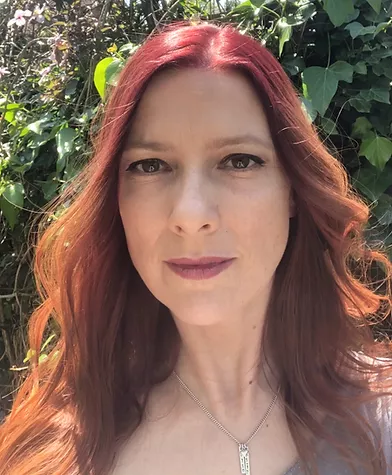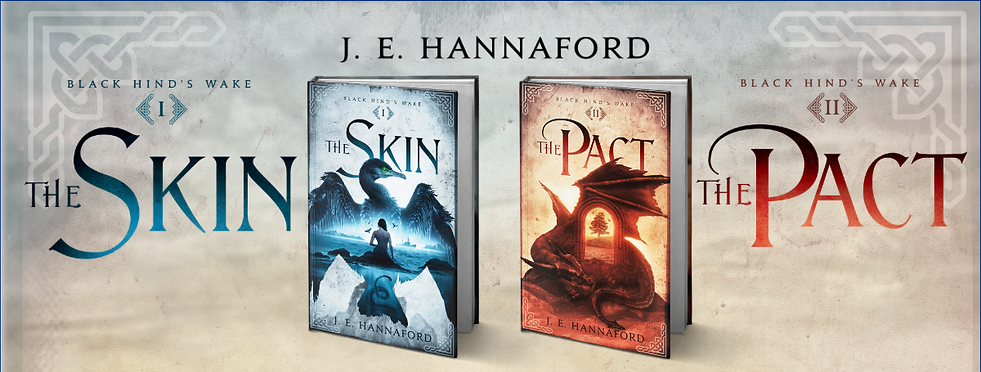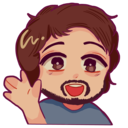March of the Sequels: J.E. Hannaford
13 Mar 2023The Author/s

J.E. Hannaford
J E Hannaford is powered by coffee, dragons, and whisky. She teaches Biology in the real world and invents fantasy beasts to populate her own.She lives in Suffolk, UK, and pines for the coast and mountains of Wales.A love of nature and the ocean washes through the pages of J E Hannaford’s stories and pours out of the characters who live in it.
Her debut series is The Black Hind’s Wake Duology.
The Interview
First of all, tell me a little about your series and introduce us to the sequel(s).
Black Hind’s Wake is the first Duology in the Black Hind books. The series follows the journey of Selkie, who sacrifices herself to protect her sister, and the challenges she has to overcome in getting her pelt back. Despite the relatively traditional opening sequence for a selkie story, It is very definitely not a typical selkie tale.
Black Hind’s Wake is set in an alternate future where the magic is fading and Old Ones, such as selkies and sirens, are captured as trophies by humans. As part of her journey, Selkie gets involved with a group of other Old Ones who are trying to preserve the world, and its magic before it’s too late, and the planet dies without its guardians.
In The Pact, the crew of Black Hind, along with Lord Sal and his ship, Barge, are asked to head north to Mynyw, to check on rumours of an army massing to attack Terrania. Mynyw is the safest place north of the Everstorm for Old Ones – a place where unknown to Selkie and Lord Sal, the peace pact between the welsh fae – Tylwyth Teg, the Welsh dragon, the selkies, and the humans is in grave peril.
It also gives us a new perspective. Maddoc is a guardian of the Pact and really, he just wants to be at home with a cheese sandwich, not having to save his realm, but he puts on his hiking boots and magical cloak, and gets on with it.

Do you find that most of your readers continue to read the whole series? Why do you think that is?
I wish more people would continue through to The Pact. It’s faster-paced than The Skin, and the timeline is linear in book two. It is also darker and delves into folklore that I feel is heavily under-represented in fantasy, despite it being widely used as a source of inspiration for many derivations of elves and fae. The Pact also allows full closure on Selkie’s story and we learn a lot more about Theo and Ria.
How difficult is it to add new characters in a sequel into already established relationships?
Adding in any new crew member to Black Hind is hard. You have to be very mindful of the relationships already in existence and the circumstances leading to needing to add a new character in – especially in such a small core crew. Black Hind has a limited number of beds, and usually is sailed by four individuals. Trying to find the right person for the job is complicated and sometimes surprising.
In The Pact, Ash and Ivy both have to step in from minor roles as members of Driftwood, into fully-fledged characters. Given the nature of their work and their individual secrets, adding in new people needs a lot of trust very quickly. I strive to figure out what links or realistic relationships people might have, that would allow for that level of openness and trust. Ventios is another, who I didn’t know if he was going to stay or not, right up until the crew discussed it with him.
Outside of Black Hind's Wake, you will publish soon Gates of Hope. How does it feel to return back to a different project?
I love the worlds and characters in Gates of Hope. It has a very different feel to Black Hind, and is more epic fantasy in style, with animal companions and a complex hard magic system. Gates of Hope is still a character-led fantasy, as the immersion in an individual character’s journey is something I very much enjoy. It is also slightly slower paced as the first book in a trilogy and there are three worlds to build in the one book.
I found that with a return to human protagonists, their worldview is more normal than Selkie. That aspect was easier to write in some ways and the style of the book is less lyrical as a result. There is also a great freedom in creating creatures entirely of my own imagination rather than working within a folklore framework. I suppose in addition, both series are set hundreds of years after the war, or catastrophic event, and so a common thread across both series is that they begin within a supposedly comfortable time period.
If I’m not wrong, you are also releasing the audiobook of The Pact soon, correct?
Yes! It’s now out, narrated again by the wonderful Emily Mount. She has brought the characters to life, and done a wonderful job. Her voice is so perfect for the slightly otherworldly Selkie.
Is it difficult to continue with worldbuilding for a world you have already built in book 1? Do you find it easier to switch locations for the sequel and start again with worldbuilding?
In Black Hind’s Wake the world is heavily research-based and folklore-led. Many of the places mentioned exist. So while it’s not hard to return to the world, because it’s ours with a particular level of sea level rise. It takes a lot of time to research locations, then I decide what new things I’m adding or altering for my version of the world. I traveled to both the Otherworld arch and the sky lakes in my research for The Pact, to allow me to really feel the area. Some of the images on the cover are my own photographs. Sadly, as the characters travel further afield I doubt that will be an option.
For any future books, Terrania will always be the base region for Barge. I went north in The Pact because I really wanted to bring the characters to my home, and feature the red rocks and wild islands of Pembrokeshire and the mountain lakes of Wales along with their folklore.
In the long term, I anticipate vessels sailing to a variety of regions as they interact with other Old Ones. It all depends where my research takes me.
Have you ever been stymied by a worldbuilding or plot detail from book 1 that is very inconvenient to deal with or write your way around in subsequent books?
Not so far! Although I did have to work out what Selkie looked like naturally by working backward from the tweaks she makes to her glamours, when I realised Maddoc would meet her and so for the first time someone would look at her.
Would you say your craft has improved with the subsequent books?
I hope so. Having rewritten much older work recently in Gates, I can see a big change. I’d like to hope that my writing continues to improve and need less wrestling into shape in the editing stage. I used to over-write, a lot. And, although my prose is somewhat poetic in places, I hope that these days it remains tight.
Do you have all the timeline planned for the full series?
I have a few ideas for potential future books, but plan to finish the Aulirean Gates trilogy in the next two years, while I deep-dive into the research needed for the next Black Hind books. I’ve had requests for more of Sirena, more of Barge, and I have a few ideas for locations I’d like the crew to visit and folklore I’d love to include, but it takes time to get the research done so I can be sympathetic to the folklore I’m playing with. I see Black Hind as a series that I can add to as long as people want to read it.
Do you have any marketing tips for sequels?
I wish I did! I’ll be following your answers on these interviews for other suggestions!
I have been told a lot to have the first book as the hook and a lower price, but with a duology it’s still a difficult route to take without a longer read-through series to follow. Keep talking about it, and don’t be afraid to offer review copies. I would also say that the series branding needs to be clear for readers.
